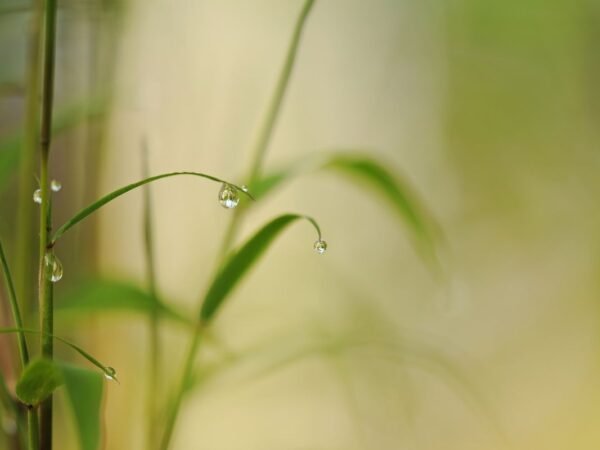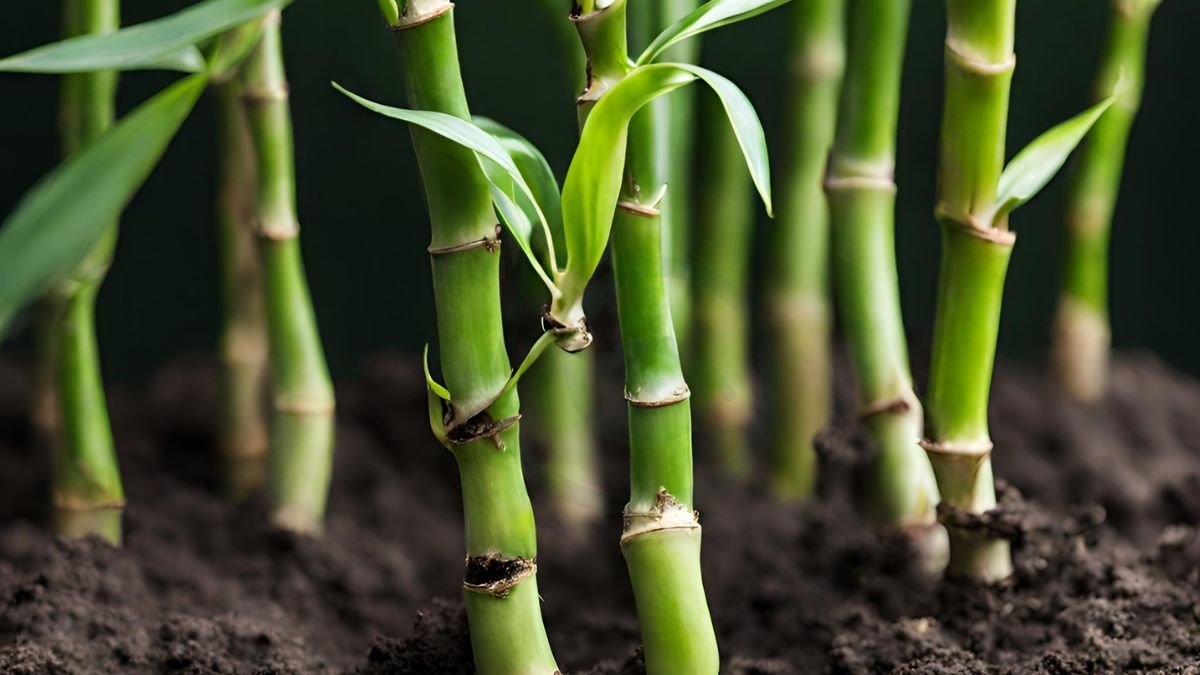
Wondering if lucky bamboo can grow in soil? You're in the right place! Let's explore this topic together and find out everything you need to know about growing lucky bamboo in soil.
Yes, lucky bamboo can indeed grow in soil, although it's not its natural habitat. Lucky bamboo, scientifically known as Dracaena sanderiana, is a versatile plant that can thrive in both soil and water. When grown in soil, it requires well-draining potting mix to prevent waterlogging, which can lead to root rot. Ensure the soil is kept consistently moist but not waterlogged, and provide indirect sunlight for optimal growth. With proper care, lucky bamboo can grow well in soil, adding a touch of greenery and luck to your indoor space.
Ready to learn more about caring for lucky bamboo and other houseplants? Stay tuned for additional tips and insights on how to nurture and maintain a thriving indoor garden!
Key Takeaways
- Understanding the needs of lucky bamboo is crucial for its growth in soil.
- Proper preparation before planting ensures a healthy environment for lucky bamboo.
- Follow specific planting steps to ensure successful growth in soil.
- Consistent care and attention are essential for the well-being of lucky bamboo plants.
- Fertilize the lucky bamboo appropriately to support its growth and development.
- Regular pruning and propagation practices help maintain the health and shape of lucky bamboo plants.
Understanding Lucky Bamboo
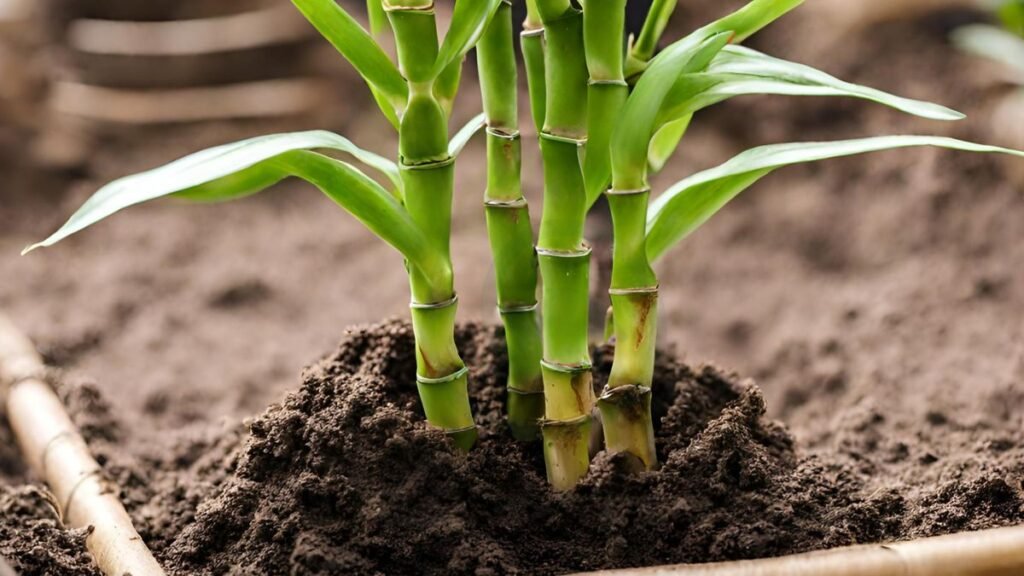
Growth Habit
Lucky bamboo typically grows in a straight, upward pattern with vibrant green leaves. It can grow up to three feet tall and about two inches wide. The leaves are arranged alternately along the stem, creating an aesthetically pleasing look.
Symbolic Significance
In various cultures, lucky bamboo symbolizes good luck, prosperity, positive energy, water, and stalks. Many believe that water brings luck and wards off negative forces. In Feng Shui practices, lucky bamboo with water-filled stalks is considered to attract positive chi energy into the space.
Indoor vs Outdoor
Growing lucky bamboo indoors requires indirect sunlight and regular watering to thrive. Outdoors, it can be grown in shaded areas with consistent moisture levels. Factors like climate, space availability, and light exposure influence whether one chooses to grow lucky bamboo indoors or outdoors.
Preparing for Planting
Choosing Soil
When planting lucky bamboo, select a well-drained and rich potting soil to ensure optimal growth and water. The appropriate soil type is crucial for the plant's health and development. Opt for soils that are airy, loose, and retain moisture without becoming waterlogged.
To promote healthy growth of lucky bamboo, understand the significance of using well-draining soil to water. This helps prevent waterlogging, which can lead to root rot. Rich potting soil provides essential nutrients for the plant's nourishment and overall well-being.
For successful growth, choose soil preferences that include good drainage properties to water. Lucky bamboo thrives in slightly acidic soils with a pH level between 5.5 and 6.5. These conditions support robust growth and vibrant foliage.
Selecting a Pot
When choosing a pot for lucky bamboo, consider the right size that allows ample room for root development. Ensure the pot has adequate drainage holes to prevent water accumulation at the roots. A shallow but wide pot is ideal for accommodating the plant's unique growth pattern.
The material of the pot is also important; opt for pots made from porous materials like clay or ceramic that allow air circulation to the roots. Decorative pots can enhance the aesthetic appeal of lucky bamboo while providing a stable environment for growth.
Explore decorative options such as ceramic pots with intricate designs or glass containers that showcase the plant's roots. Choose a pot that complements your interior decor while meeting the needs of lucky bamboo's growth requirements.
Necessary Tools
Gather essential tools such as pruning shears, scissors, watering cans, and fertilizer to care for your lucky bamboo effectively. Each tool serves a specific purpose in maintaining the health and appearance of your plant.
Pruning shears are used to trim yellowing or damaged leaves, promoting new growth and maintaining a tidy appearance. Scissors come in handy for precise trimming tasks and grooming the plant's foliage.
Ensure you have all necessary tools on hand for successful propagation through stem cuttings or repotting when needed. Proper tools ensure you can address any issues promptly and keep your lucky bamboo thriving.
Planting Steps
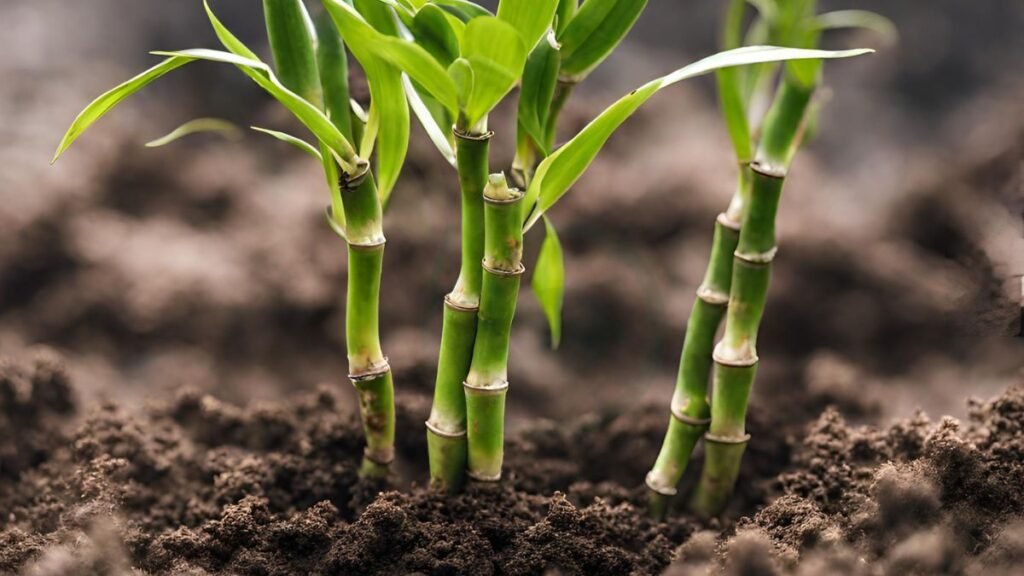
Soil Preparation
To plant lucky bamboo in soil, prepare the soil by ensuring it is well-aerated and retains moisture. This step is crucial for the plant's health.
Proper aeration in the soil allows the roots to breathe and prevents waterlogging, promoting healthy growth. Understanding this aspect is key.
Plant Positioning
When deciding where to place your lucky bamboo, consider factors like light exposure and temperature. Optimal positioning ensures the plant thrives indoors.
Ensure there is adequate air circulation around the plant to support its growth. This factor contributes significantly to its overall health.
Initial Watering
After planting, water your lucky bamboo appropriately. Keep the soil evenly moist, but avoid overwatering as it can harm the plant during its initial growth stages.
Proper watering techniques are essential for the plant's development. Avoid waterlogging to prevent root rot and promote a healthy root system.
Care Requirements
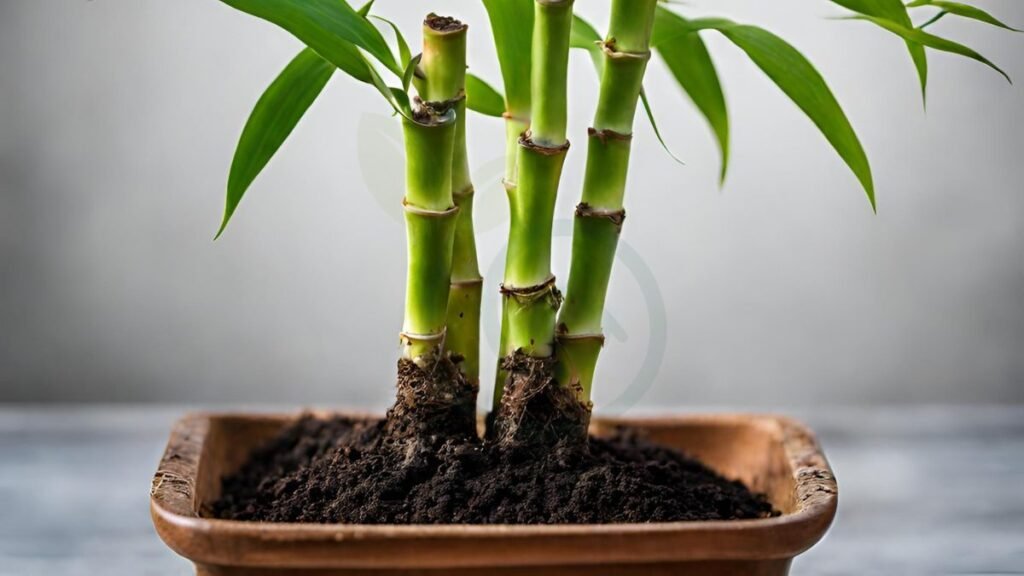
Watering Techniques
To keep lucky bamboo thriving in soil, water it sparingly to avoid waterlogged conditions that can lead to root rot. Ensure the soil is slightly damp but not soggy. Overwatering can harm the plant.
Understanding the frequency and quantity of water needed is crucial for healthy growth. Lucky bamboo prefers distilled or purified water to prevent build-up of minerals. Use a watering can with a narrow spout for precision.
Implementing proper watering practices is essential to prevent issues like root rot and yellowing leaves. Adjust watering frequency based on environmental factors such as humidity levels.
Sunlight Needs
Position lucky bamboo in indirect sunlight to thrive. Direct sunlight can scorch its leaves, causing damage. Place the plant near a window with sheer curtains or in an area with bright, filtered light.
Ensure your lucky bamboo receives enough light without being exposed to harsh, direct sun rays. Too much sunlight can lead to leaf burn and stunted growth. Monitor the plant's response to its current light exposure.
Temperature and Humidity
Maintain a consistent temperature range between 65-90°F (18-32°C) for optimal growth of lucky bamboo. Avoid placing the plant near drafty windows or vents that can cause temperature fluctuations.
Keep lucky bamboo in an environment with moderate humidity levels around 40-60%. Low humidity can result in dry, crispy leaves, while high humidity may promote mold growth on the soil surface.
Fertilizing Practices
Choosing Fertilizer
Lucky bamboo can grow in soil, benefiting from balanced liquid fertilizer with equal nitrogen, phosphorus, and potassium. Opt for a fertilizer labeled specifically for lucky bamboo to provide essential nutrients.
When selecting a fertilizer, look for a balanced N-P-K ratio, such as 10-10-10 or 20-20-20, suitable for lucky bamboo's growth. Avoid fertilizers high in salts or fluoride content.
Application Frequency
To ensure optimal growth, apply liquid fertilizer every two to four weeks during the growing season, typically spring and summer. During fall and winter, reduce the frequency to once every six to eight weeks.
Over-fertilizing can lead to burnt roots and yellowing leaves, so it's crucial to follow the recommended application frequency. Monitor your plant's response to adjust the fertilization schedule accordingly.
Pruning and Propagation
Pruning Techniques
Lucky bamboo requires occasional pruning to maintain its shape and health. Trimming the yellow or damaged leaves with sharp, clean scissors promotes growth. Regularly cutting the stalk at a 45-degree angle helps control the plant's height.
When pruning, ensure to remove any unhealthy or discolored sections to prevent them from spreading. Prune the stalks just above a node to encourage new growth. Regularly inspect your lucky bamboo for any signs of pests or diseases.
Propagating Stalks
To propagate lucky bamboo, start by selecting a healthy parent plant with vibrant green leaves. Cut a healthy stalk just below a node using a sharp, sterile knife. Place the cutting in a container filled with water, ensuring that the node is submerged.
Change the water every two weeks to keep it fresh and free from bacteria. After a few weeks, you will notice roots starting to grow from the node. Once the roots are around two inches long, you can transfer the cutting into soil for further growth.
Troubleshooting Common Issues
Yellowing Leaves
Yellowing leaves on lucky bamboo can indicate issues like overwatering or too much direct sunlight. Ensure the plant receives indirect light and maintain proper watering to prevent yellowing.
Lucky bamboo thrives in moderate light conditions and should be kept away from drafts or extreme temperatures. Trim any yellow leaves to encourage new growth and maintain plant health.
Root Rot Prevention
Prevent root rot by using well-draining soil and pots with drainage holes to avoid waterlogging. Monitor the soil moisture levels regularly and adjust watering accordingly.
To further prevent root rot, avoid leaving the plant sitting in water for extended periods. Ensure proper drainage after watering to keep the roots healthy and free from rot.
Dealing with Pests
Common pests that affect lucky bamboo include spider mites and aphids. Use a gentle insecticidal soap solution to treat infestations, ensuring to cover both sides of the leaves thoroughly.
Regularly inspect the plant for signs of pests, such as webbing or tiny bugs. Isolate infected plants to prevent the spread of pests to other indoor plants in your collection.
Repotting Guidelines
Signs to Repot
Lucky bamboo needs repotting when roots outgrow the container or the plant becomes top-heavy. Check for crowded roots circling the pot's bottom and water overflow during watering.
Over time, the soil depletes nutrients, leading to stunted growth. If you notice yellowing leaves or slow growth, it's time to repot. Inspect for mold on the soil surface, indicating poor drainage.
Repotting Steps
- Select a larger pot: Choose a container with drainage holes. Use well-draining soil like a mix of peat moss and perlite.
- Prepare the plant: Gently remove the lucky bamboo from its current pot and shake off excess soil.
- Trim roots if necessary: Prune any brown or mushy roots to promote healthy growth.
- Position in new pot: Place the plant in the center of the new container at the same depth as before.
- Add fresh soil: Fill around the roots with fresh soil, pressing down lightly to secure the plant.
- Water thoroughly: Water until it drains from the bottom, ensuring proper hydration for your lucky bamboo.
Reviving Lucky Bamboo
Identifying Stress Signs
Lucky bamboo can show signs of stress if not growing properly. Yellowing leaves indicate overwatering, while brown tips suggest underwatering. Weak stems may signal inadequate light.
To ensure your lucky bamboo thrives, watch out for these stress signals. Yellow leaves mean too much water, brown tips signal dehydration, and weak stems point to insufficient light.
Recovery Steps
- Adjust watering: If the leaves are yellow, reduce watering frequency. For brown tips, increase watering.
- Light exposure: Place in indirect sunlight for 4-6 hours daily to strengthen the plant.
- Pruning: Trim yellow leaves or brown tips to promote new growth and enhance appearance.
Revive your lucky bamboo by adjusting watering levels, providing adequate light exposure, and pruning damaged parts.
Closing Thoughts
In mastering the art of nurturing lucky bamboo, you've equipped yourself with the knowledge to ensure its thriving growth. From understanding its needs to troubleshooting common issues, you're now well-versed in caring for this resilient plant. Remember the importance of proper planting, regular fertilizing, and occasional pruning to maintain its health and beauty. By following these guidelines, you can enjoy a lush and vibrant lucky bamboo in your space.
Don't hesitate to share your newfound expertise with fellow plant enthusiasts or reach out for assistance if needed. Your commitment to providing optimal care for your lucky bamboo not only enhances your surroundings but also fosters a deeper connection with nature. Keep up the excellent work in cultivating your green companion!
Frequently Asked Questions
Can Lucky Bamboo Grow in Soil?
Yes, lucky bamboo can grow in soil, but it thrives better in water or a well-draining potting mix. If planting in soil, ensure it is loose, rich in nutrients, and not waterlogged to prevent root rot.
How Often Should I Fertilize Lucky Bamboo?
Fertilize lucky bamboo every 2-4 weeks during the growing season with a balanced liquid fertilizer diluted to half strength. Avoid over-fertilizing as it can lead to salt buildup and damage the plant.
Why Is My Lucky Bamboo Turning Yellow?
Yellowing of lucky bamboo leaves can be due to overexposure to direct sunlight, chlorine or fluoride in water, inadequate watering, or poor drainage. Adjust light levels, use filtered water, maintain proper watering practices, and ensure good drainage.
When Should I Repot My Lucky Bamboo?
Repot your lucky bamboo when it outgrows its current container or shows signs of overcrowding. Typically, repotting every 1-2 years in spring is recommended. Choose a slightly larger pot with fresh well-draining soil.
How Do I Revive an Unhealthy Lucky Bamboo Plant?
To revive an unhealthy lucky bamboo plant, assess its care conditions such as light exposure, watering frequency, and drainage. Trim any yellow or mushy roots, change the water or soil if needed, adjust care routine based on the plant's specific requirements.
Image Source: Paid image from CANVA



